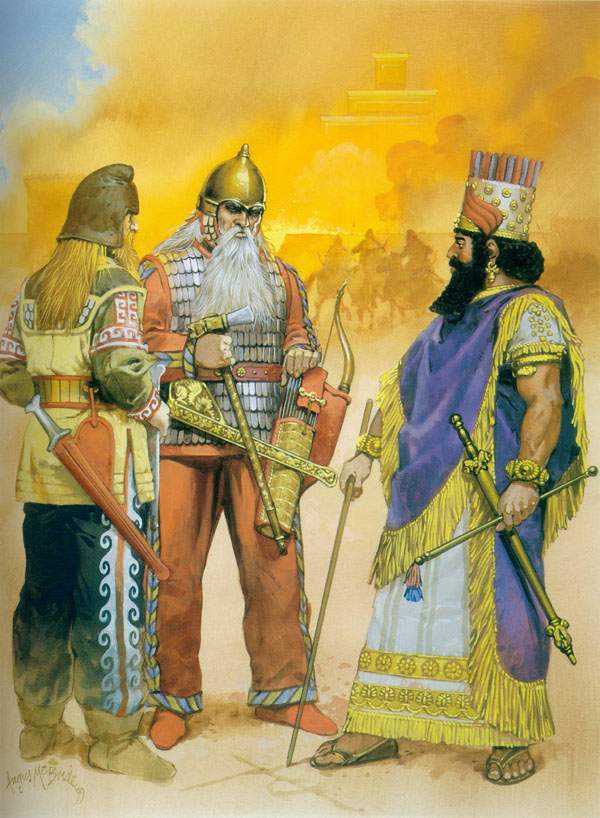Nabopolassar, king of Babylon, and the king of Scythia at the fall of Nineveh, 612 BCE by Angus McBride
"The Scythians make their first major appearance in the fertile crescent during the 7th and 6th centuries BCE. It is during this time that the nomadic horse archers engage the region’s strongest power up to that date, the Neo Assyrian Empire under Esarhaddon. Presumably, after the Scythians engaged and defeated the Assyrians in a skirmish, Esarhaddon agreed to marry his daughter to the Scythian Chieftain Partatua (whose name meant "with far-reaching strength.") Bartatua was the successor of the previous Scythian king, Išpakaia, and might have been his son. After Išpakaia had attacked the Neo-Assyrian Empire and died in battle against the Assyrian king Esarhaddon around 676 BCE, Bartatua succeeded him. After this event, the Scythians continued to engage in continuous raids throughout the Near East, from Palestine to Egypt. Eventually, the Scythians took part in the biblical event that was the end of the Neo Assyrian Empire, contributing to the sack of Nineveh.
Both in terms of culture and military, the Scythians would have been a shock to the major powers of the time, the Babylonians and Assyrians. Being a series of tribal confederations rather than a concrete nation with cities, any form of retaliation against the Scythians would be nearly impossible (as Cyrus the Great would later find out). The Scythians, being nomads, would attack swiftly with their infamous horse archers, using well-crafted composite bows. The Scythians would then finish the job with heavy cavalry covered in metal scales, which would no doubt be a shock to the Semitic peoples of the Middle East, used to encountering heavy infantry, archers and chariots of Assyria and Egypt.
The presence of women within Scythian society would have been even more of a shock to the states of the Middle East. The Scythians, and particularly their relatives, Sarmatians were famous for their fierce warrior women. In Scythian armies, women were expected to fight alongside their men on horseback. This gave rise to the mythological “Amazons” who indeed had a basis in historical reality. Archaeology confirms this, as many Scythian women are buried with weapons.
The Scythians also took part in the greater economic cultural exchange of the Middle East. Besides trading their prestigious bows, Scythian art appears to be found in Middle Eastern cities such as Urartu and Middle Eastern bowls and jewelry appear in Scythian graves as well. It is even theorized that after seeing Middle Eastern art, the Scythians blended it with their own art style, resulting in the Scythian “animal style” of art, for which the Scythians are famous. The Middle Eastern art adopted by the Scythians would then be spread all over the Middle East and Europe as well. Imagery depicting animals and the hunting of various beasts is thought to have been a product of this cultural exchange, adding to the brilliant craftsmanship of the Scythians."
-taken from arabamerica and wikipedia
 | |
|
 |
| Another version. |
 |
| Bigger image, but it's cropped. |
Source/Quote:


Comments
Post a Comment